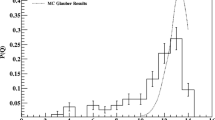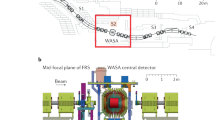Abstract
We revisit previous measurements for the hypertriton binding energy with nuclear emulsion which were published in 1968 and 1973. Using Monte Carlo simulations, the systematic error of the hypertriton binding energy in emulsion measurements has been estimated to be approximately 28 keV. We corroborate the recent works that re-evaluate the hypertriton binding energy by using the former emulsion measurements in the present work, and the ambiguities and difficulties of the reevaluation are observed. Considering the need of new precise measurements with a well-controlled systematic error, we introduce a new approach by analyzing the existing nuclear emulsion data from the J-PARC E07 experiment, from which the binding energy of hypertriton could be determined, with both statistical and systematic errors, to be approximately 30 keV with 400 events.

Similar content being viewed by others
Data Availability Statement
This manuscript has no associated data or the data will not be deposited. [Authors’ comment: All data generated or analyzed during this study are included in this published article.]
References
M. Danysz, J. Pniewski, Lond. Edinburgh Dublin Philos. Magazine J. Sci. 44(350), 348 (1953). https://doi.org/10.1080/14786440308520318
D. Davis, Nuclear Phys. A 754, 3 (2005). https://doi.org/10.1016/j.nuclphysa.2005.01.002.https://www.sciencedirect.com/science/article/pii/S0375947405000047
O. Hashimoto, H. Tamura, Progress Part. Nuclear Phys. 57(2), 564 (2006). https://doi.org/10.1016/j.ppnp.2005.07.001.https://www.sciencedirect.com/science/article/pii/S0146641005000761
A. Feliciello, T. Nagae, Rep. Prog. Phys. 78(9), 096301 (2015). https://doi.org/10.1088/0034-4885/78/9/096301
C. Rappold, J. Phys: Conf. Ser. 668, 012025 (2016). https://doi.org/10.1088/1742-6596/668/1/012025
G. Bohm et al., Nuclear Phys. B 4(6), 511 (1968). https://doi.org/10.1016/0550-3213(68)90109-0.http://www.sciencedirect.com/science/article/pii/0550321368901090
M. Jurič, G. Bohm, J. Klabuhn, U. Krecker, F. Wysotzki, G. Coremans-Bertrand, J. Sacton, G. Wilquet, T. Cantwell, F. Esmael, A. Montwill, D. Davis, D. Kiełczewska, T. Pniewski, T. Tymieniecka, J. Zakrzewski, Nuclear Phys. B 52(1), 1 (1973). https://doi.org/10.1016/0550-3213(73)90084-9. https://www.sciencedirect.com/science/article/pii/0550321373900849
The STAR Collaboration, Measurement of the mass difference and the binding energy of the hypertriton and antihypertriton (2019). https://doi.org/10.1038/s41567-020-0799-7.https://arxiv.org/abs/1904.10520v1
Y.H. Leung. Hypernuclei and anti-hypernuclei production in heavy-ion collisions. https://indico.cern.ch/event/985652/contributions/4296086/attachments/2248875/3814733/sqm2021hypernucleiv7.pdf
M. Rayet, R.H. Dalitz, Nuovo Cimento A 46, 786 (1966). https://doi.org/10.1007/BF02857527
A. Pérez-Obiol, et al., Phys. Lett. B 811, 135916 (2020). https://doi.org/10.1016/j.physletb.2020.135916. http://www.sciencedirect.com/science/article/pii/S037026932030719X
C. Rappold et al., Nuclear Phys. A 913, 170 (2013). https://doi.org/10.1016/j.nuclphysa.2013.05.019.https://www.sciencedirect.com/science/article/pii/S0375947413005940
L. Adamczyk et al., Phys. Rev. C 97, 054909 (2018). https://doi.org/10.1103/PhysRevC.97.054909
J. Chen et al., Physi. Rep. 760, 1 (2018). https://doi.org/10.1016/j.physrep.2018.07.002.https://www.sciencedirect.com/science/article/pii/S0370157318301753
S. Acharya et al., Phys. Lett. B 797, 134905 (2019). https://doi.org/10.1016/j.physletb.2019.134905.https://www.sciencedirect.com/science/article/pii/S0370269319306276
Y. Toyama, et al., Proceedings of the 8th International Conference on Quarks and Nuclear Physics (QNP2018) (2019). https://doi.org/10.7566/jpscp.26.031018
T.R. Saito et al., Nat. Rev. Phys. (2021). https://doi.org/10.1038/s42254-021-00371-w
H. Asano, et al. \(^3_{\Lambda }{{\rm H}}\) and \(^4_{\Lambda }{{\rm H}}\) mesonic weak decay lifetime measurement with \(^{3,4}{{\rm He}}({{\rm K}}^{-},\pi ^{0})^{3,4}_{\Lambda }{{\rm H}}\) reaction. http://j-parc.jp/researcher/Hadron/en/pac_1901/pdf/P73_2019-06.pdf
M. Agnello, et al. Direct measurement of the \(^3_{\Lambda }{{\rm H}}\) and \(^4_{\Lambda }{{\rm H}}\) lifetimes using the \(^{3,4}{{\rm He}}(\pi ^{-},{{\rm K}}^{0})^{3,4}_{\Lambda }{{\rm H}}\) reactions. http://j-parc.jp/researcher/Hadron/en/pac_1901/pdf/P74_2019-08.pdf
P. Achenbach, et al., PoS Hadron2017, 207 (2018). https://doi.org/10.22323/1.310.0207. https://pos.sissa.it/310/207/pdf
P.A. Zyla et al., Progress Theor. Exp. Phys. (2020). https://doi.org/10.1093/ptep/ptaa104
W. Huang et al., Chin. Phys. C 41(3), 030002 (2017). https://doi.org/10.1088/1674-1137/41/3/030002
M. Wang et al., Chin. Phys. C 41(3), 030003 (2017). https://doi.org/10.1088/1674-1137/41/3/030003
P. Liu et al., Chin. Phys. C 43(12), 124001 (2019). https://doi.org/10.1088/1674-1137/43/12/124001
A. Ariga et al., Nuclear emulsions (Springer International Publishing, Cham, 2020), pp. 383–438. https://doi.org/10.1007/978-3-030-35318-6_9
W.H. Barkas, Pure& Applied Physics Series, I II, vol. 15. (Academic Press, Cambridge, 1963)
H.H. Heckman et al., Phys. Rev. 117, 544 (1960). https://doi.org/10.1103/PhysRev.117.544
G. Bohm et al., Nuclear Phys. B 48(1), 1 (1972). https://doi.org/10.1016/0550-3213(72)90047-8.http://www.sciencedirect.com/science/article/pii/0550321372900478
J. Mattauch et al., Nuclear Phys. 67(1), 73 (1965). https://doi.org/10.1016/0029-5582(65)90116-1.https://www.sciencedirect.com/science/article/pii/0029558265901161
A. Wapstra, N. Gove, Atom. Data Nuclear Data Tables 9(4), 267 (1971). https://doi.org/10.1016/S0092-640X(09)80001-6.https://www.sciencedirect.com/science/article/pii/S0092640X09800016
L. Huanling, H. Dingding, M. Yugang, Z. Liang, Sci. China Phys. Mech. Astronomy (2020). https://doi.org/10.1007/s11433-020-1552-2
T.H. Shao, J.H. Chen, C.M. Ko, K.J. Sun, Z.B. Xu, Chin. Phys. C 44(11), 114001 (2020). https://doi.org/10.1088/1674-1137/abadf0
B. Dönigus, Eur. Phys. J. A (2020). https://doi.org/10.1140/epja/s10050-020-00275-w
K. Imai, K. Nakazawa, H. Tamura. J-PARC E07 experiment. Systematic Study of Double-Strangeness System with an Emulsion-Counter Hybrid Method. http://j-parc.jp/researcher/Hadron/en/pac_0606/pdf/p07-Nakazawa.pdf
Acknowledgements
We thank Professor K. Nakazawa of Gifu University for constructive discussions.
Author information
Authors and Affiliations
Corresponding author
Additional information
Communicated by Klaus Peters.
Rights and permissions
About this article
Cite this article
Liu, E., Kasagi, A., Ekawa, H. et al. Revisiting the former nuclear emulsion data for hypertriton. Eur. Phys. J. A 57, 327 (2021). https://doi.org/10.1140/epja/s10050-021-00649-8
Received:
Accepted:
Published:
DOI: https://doi.org/10.1140/epja/s10050-021-00649-8




